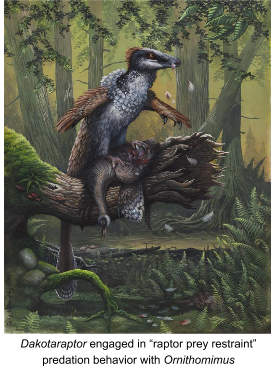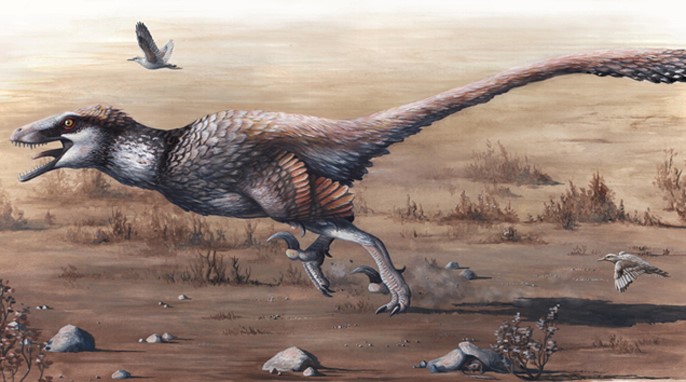By Featured Guest David Blagic
David is a young, amateur paleontologist and student of vertebrate paleontology. He lives in Mladenovac, Serbia. At 14 years old, he enjoys writing on the behavior, morphology, phylogeny, and evolution of dinosaurs, particularly Theropods such as Maniraptorans and Carnosaurs. Connect with him on Google Plus or YouTube.
Dakotaraptor steini
Dakotaraptor steini is a newly discovered species of dromaeosaurid dinosaur. First remains of this species were discovered in 2005, in the Hell Creek Formation, but it has officially been named only this year. Dakotaraptor steini was about 6 m (20 ft) long and 2 m (7 ft) tall. It was certainly one of the largest dromaeosaurid dinosaurs and is rivaling Utahraptor ostrommaysorum for the title of the biggest. Upper size estimations for U. ostrommaysorum put it at about 8 m in linear and 2 m in vertical dimension. As anyone can conclude from looking at the given dimensions, Utahraptor was certainly a longer animal. But what about its mass? Mass can be easily measured by looking at the leg bone size ratio. There are two types of legs in bipedal animals: legs designed for speed and legs designed to support great amounts of pressure. The second type of legs is, quite logically, common among the massive animals and has these two characterizations:
- Femora is longer than tibiae. “We know that Ornitholestes was one of the fast running dinosaurs, and we can tell that because it possesses relatively short femora compared to its tibiae. The speed of a bipedal animal can be roughly determined by the ratio of its two leg bones—a short tie and a long shin add up to a fast runner” (Horner et al. 2001).
- Tibiae and tarsi (in Maniraptorans fused into tibiotarsi) are longer than metatarsi. “Bipedal running speed in digitigrade animals (that is, those that walk on their toes like birds rather than their ankles like humans) is usually roughly determined by the ratio of the lower leg bones (the tibia/tibiotarsus) to the upper foot bones (the metatarsus). The longer the upper foot is in length compared to the lower leg, the faster an animal could run” (Martyniuk et al. 2010).


Artwork by Emily Willoughby
A Heavyweight Predator
According to Blasing, U. ostrommaysorum, “… unlike most of its cousins, wasn’t built just for speed. Its short and robust legs mean that this predator was a heavyweight … Based on the Utahraptor’s large size, and previously given proportions of the leg bones, it’s pretty safe to assume that it was slower than other dromaeosaurids, such as Velociraptor and Deinonychus. It was probably more of an ambush predator” (Blasing et al. 2008).
But according to Robert DePalma’s original paper describing D. steini, , despite being about the same size as U. ostormmaysorum, “…the hind limb is built lightly and with long elements, contrary to the robust, stocky hind limbs of Utahraptor. Dakotaraptor more closely resembles the agile, springy, smaller dromaeosaurids and would have been well-suited at running and pursuit predation” (DePalma et al. 2015). The morphology of the leg in D. steini indicates it really was less massive than U. ostrommaysorum, eliminating Dakotaraptor as a contestant for the title of the biggest dromaeosaur.
Knowing what type of predation this animal preferred and the morphology of the hind limbs puts this genus as more closely related to the much smaller and much more agile Velociraptorines such as Velociraptor than to the large, and relatively slow, advanced Dromaeosaurines.
Dakotaraptor Sexual Dimorphism
Two morphs, a robust and a gracile one, were present in the fossil material. A study of the bone histology showed that both morphs were adult, so the lighter build of some bones was not caused by younger age. A possible explanation for this is sexual dimorphism. However, it has not been determined which size was male and which was female. Some paleontologists think that females required a larger body design than males, in order to protect the juveniles and eggs. However, in modern ostriches, males take care of the nest and offspring, so the mystery remains.
Wings and Social Skills
On its ulna, D. steini possesses 15 quill knobs, tiny holes in arm bones where feathers were attached. Not all animals that possess feathers have quill knobs; for example, flamingos and herons do not possess quill knobs, but they have feathers. But all animals with quill knobs have feathers. So, it can be surmised that Dakotaraptor possessed wings.
Since it is found in the Hell Creek Formation, there is no doubt D. steini coexisted with Tyrannosaurus rex, Triceratops horridus, Troodon formosus, and many more famous North American dinosaurs. Like most Deinonychosaurs, it is believed that Dakotaraptor lived in packs and were very social animals.
References
Dinogoss, a Blog about Stem Birds
The furculae of the dromaeosaurid dinosaur Dakotaraptor steini are trionychid turtle entoplastra
Dakotaraptor: Giant Raptor Straight Out of Hell Creek
Blasing et al. (2008). Jurassic Fight Club, Episode 8-9: Raptors’ Last Stand and Jurassic Killers
Horner, J. (2001). Valley of the T. Rex
Image courtesy of GotScience Contributor Emily Willoughby
GotScience.org translates complex research findings into accessible insights on science, nature, and technology. Donate or visit our gift shop. For more science news subscribe to our weekly digest.

